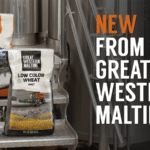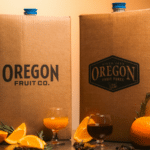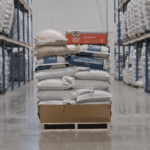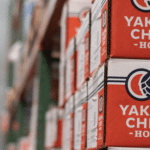
TO SILO OR NOT TO SILO, THAT IS THE QUESTION
by Jeff Hughes
The Allure and Benefits of a Silo
Even in the current COVID-19 environment, many smaller to mid-size breweries are still faced with expansion decisions. As these breweries taste success, either despite or because of the pandemic and continue to sell out of beer at their current facilities, there is sometimes an insatiable urge to go big or go home. The allure of adding a silo to an expanding production brewery certainly exhibits some validity. The sheer sight of a silo, with its billboard-like brewery signage, is impactful to prospective consumers. The ease of receiving malt and increased efficiency with the proper grain delivery/milling systems certainly streamlines brewery operations. Then of course there is arguably the biggest reason to install a silo, the cost savings. You can typically expect to save 25-40% on base malt. Who would not want to add that type of savings to their bottom line?
Consider This
The initial expense is not just the silo but a properly engineered concrete pad along with a grain delivery system. Appropriate sizing is important as a typical truckload is 48,000 lbs. Your silo should have a minimum capacity of 60,000 lbs. You need some headspace to accommodate the 30° inverse cone that is formed when the malt is pneumatically blown into the silo. You also need that extra space in case you need to accommodate for some remaining material while filling.
Another consideration that typically gets overlooked when properly sizing a silo is density consideration of the grain that will be stored. For instance, 25 metric ton of Raw Wheat at 60lbs/Cubic Foot requires 920 cubic feet of bin capacity. Meanwhile, 25 metric ton of barley malt at 34 lbs/Cubic Foot requires 1,670 cubic feet of bin capacity. We have seen brewers buy silos based on standard “21 MT of grain”, and end up with bins sized way too small based on the stowage factor/density of Raw Wheat and other non-malted barley silo manufacturers.
While we do not recommend smaller than a 60,000 lb silo, it can certainly be an option for those looking for smaller loads. However, cost savings would be substantially less for a truck load that is not full, as the price of the delivered material is higher.
It is a good idea to add sight glasses to visually inspect the grain levels. Most brewery scales have a margin of error of around 2% so trying to manage the inventory in the silo by usage weight is not entirely accurate. You should also have the means to remove grain, dust, and chaff from a silo before it proceeds into the grain delivery system.
There is also some maintenance and management to consider with a grain silo. Like many things, the adage “you get what you pay for” applies to grain bins. If you choose some initial savings and go with a corrugated walled silo, regular seam inspection is necessary to maintain the general integrity and moisture control. There is also more initial setup, as corrugated silos need to be assembled on site. Straight-walled, steel welded silos offer a much better option when considering moisture control and longevity. In addition to the general integrity of the construction, quality silo manufacturers will apply a food-safe epoxy coating on the interior to prevent long-term rusting and protect the grain inside. It may be wise not to skimp here, long term benefits justify the initial increased expense. As previously mentioned, integrating the means to remove material from a silo is important to consider. A top layer of dust and chaff will deepen with every pneumatic fill if not emptied between deliveries. Having the ability to easily empty that out before it gets into your grain delivery system or mash tun avoids potential problems.
In addition to the silo itself, you cannot forget about conveyance. Two of the main options are screw auger and chain disk. The auger, a tube with a corkscrew-like shaft snaked through it, is the cheaper of the options. A motor rotates the shaft, progressing the grain. Flex augers use PVC tubing and a flexible shaft allowing angled sections. The downside of this auger conveyance is that it has limitations on sharp turns and inclines, and is generally less gentle on the grain. On the other hand, by pulling segmented disks through a tube, the chain disk conveyors can transfer grain in special conditions like long vertical runs and consecutive tight corners. They are easily scalable and more durable, and can move grain more quickly and gently than augers; however, they come with a higher price tag.
Outside of the equipment and installation, additional expenses like permits and/or attorney’s fees for city approval and zoning hearings can also increase costs substantially. At the end of the day, be prepared to spend at least $35,000 – $45,000 as a starting point, and much more for higher quality and intricate design requirements.
Considering all current, dynamic aspects of a challenging craft beer market, expanding responsibly may determine the overall health of a growing brewery. The business’s financial health, general well-being, and future may depend on it.
Does your volume justify a silo?
A general rule of thumb is that you should be able to take at least 6-8 full truckloads annually to justify a silo. As mentioned earlier, a full truckload of malt is about 48,000 lbs. That’s approximately 60 batches of beer for a 20bbl brewery, that uses an average of 40lbs of base malt per barrel of beer produced. To put that in perspective, if you brewed 10 batches a week you would need a silo fill every 6 weeks. That translates into about 8 silo fills annually with a yearly production of around 10,000 bbls.
Along with the significant savings also comes the need for increased cash flow.
Filling a silo generally costs between $15,000-$18,000, and is typically required to be paid in 30 days. This could prove difficult and place some burden on an operation that may not have appropriate operating capital. Are your sales going to provide the cash flow necessary to keep your brewery financially healthy? With increased production, is there a detailed plan to sell the new surplus of beer? Is it realistic to execute that plan? Expanding from a smaller, brewery taproom only and/or localized distribution to larger-scale distribution poses many challenges. The shelves of beer sections in grocery and beverage centers are increasingly saturated and the competition is fierce. Grocery chains often only define their shelf sets bi-annually and it can be extremely difficult to gain space in this segment. Big beer and larger craft generally have more leverage and sales advantages over smaller craft.
Will your distributors sell your beer? Jumping from your locally supported and safe backyard pond into the shark-infested ocean of the mainstream craft distribution market can be an eye-opening experience. Many breweries struggle mightily with this transition and as a result find themselves exposed financially. One strategy winning favor among larger craft is joining forces in order to centralize/streamline sales and administration strategies. The Victory/Southern Tier/Sixpoint merger is a prime example. If feasible, it seems smaller craft may want to consider this strategy in order to remain competitive and sell more beer.
Not Ready for a Silo?
There are other expansion options available to save money and streamline the brewing process. If it is determined a silo is not currently the best decision, 1,100 or 2,200 lb. totes (or supersacks) are certainly an option worth considering. Building a customizable tote setup is a fraction of the cost of an initial silo setup. A tote stand with load cells, an iris valve to control flow, and a simple hopper with delivery to the mill is a great, cost-effective setup that streamlines operations, along with the added efficiency you can expect cost savings as well. Not quite the 25-40% you may experience with silo malt, but still a significant 10-20% savings can be expected with totes. In addition, when you decide the silo is appropriate, you can still utilize your tote handling set up for your specialty malts/grains.
At Country Malt Group we offer a discount off our best tier 5 (640+ bag, full truckload) pricing for single 1,100 lb. half tote and 2,200 lb. full totes. We can also custom blend totes specific to your recipe, another great solution for those wanting to take advantage of totes! Contact your Territory Manager if you would like to discuss your specific project. We are happy to assist, answer any questions you may have, and help you accomplish your malt and grain handling
Want to learn more about Silos? Listen to the “Bulking Up: Going from Bags to Bulk” episode of The BrewDeck Podcast featuring Jack Paulson! Jack shares how to select a silo for a craft brewery and weigh the best options for different projects and budgets. Available on Spotify, Apple Podcasts, and on our website.























































































